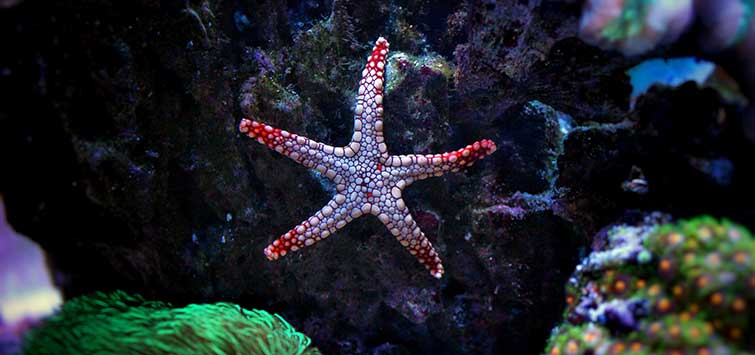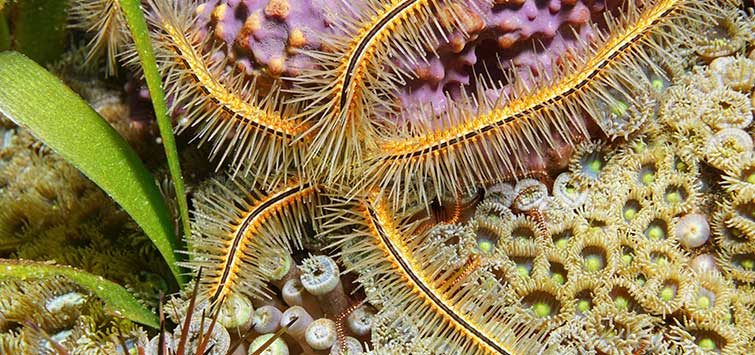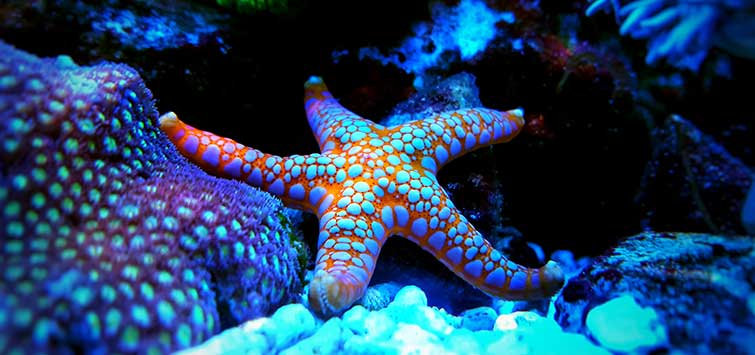Sea Stars for the Marine Aquarium
Author: Richard Aspinall
Sea stars are interesting creatures that hail from a group of animals (echinoderms) with a fascinating lineage and remarkable biological adaptations suitable for every possible marine environment. It has been suggested that species within the phylum Echinodermata may amount to more biomass than any other phylum of multicellular animals. They are, after all, found in every sea, inhabiting every ecological niche and depth from the abyssal plains to shallow rocky shores.
Echinoderm Naming and Biology
The name “echinoderm” derives from the Greek words “ekhinos” and “derma” for “hedgehog” and “skin” and relates more perhaps to sea urchins (the word “urchin” derives from “ekhinos” also) than other members of the phylum. I should add, for the benefit of those who don’t have them in their part of world, the hedgehog is a remarkable animal almost entirely covered by spines, a little like a small porcupine.
Radial Symmetry
Echinoderms share the common feature of radial symmetry. This is true whether they are Ophiuroidea (brittle stars), Echinoidea (sea urchins and sand dollars), Crinoidea (sea lilies), Holothuroidea (sea cucumbers), or the sea stars in the class Asteroidea, which we will focus on here.
What is radial symmetry? Imagine a wheel with spokes; the spokes radiate from a central axis. Echinoderms’ arms, or tentacles, radiate from a central point, where the mouth and/or anus is located. The perfect symmetry of sea stars is often illustrated in numerology by the Fibonacci sequence, which illustrates an elegant yet complex mathematical ratio of perfect symmetry. In sea urchins and sand dollars, the arms are folded back and fused to form a durable skeleton called a test, which can often be found washed up on a beach.
Only with the spines missing can you see the fused plates that radiate out from a central point. The phylum shows five and multiples of five legs or limbs, though this doesn’t hold entirely true. I know of some very large asteroids in UK waters (Crossaster spp.) that have a dozen limbs.
Tube Feet
Another feature shared by all echinoderms, though used less for locomotion in some families, is “tube feet.” If you examine a sea star or urchin or allow a star to attach to you, you will notice many hundreds of tiny tubes emerging from the animal.
Each one of these can be controlled independently, and the pressure within each can be varied, to create many hundreds of tiny “feet” that allow the animal to move by clinging to almost any surface. This vascular system is a miracle of highly complex internal plumbing and is unique to echinoderms. Some species appear to use the function less; brittle stars will use their arms for locomotion, for example.
Because this article is about sea stars, I will not mention in depth the complicated and strangely beautiful structure that exists within many echinoderms, such as those that form a test and feeding apparatus. Rest assured, though, that the phylum contains some fascinating biology.
Asteroidea
The asteroid, or sea star, family contains roughly 2000 species. They are found in all seas, oceans, depths, and habitats and can exist in bewildering numbers. Asteroids form an important prey source for larger animals, and, in turn, many are active and remorseless predators.
Asteroids feature the same basic body plan (multiples of five being the norm), though there are some genera, such as the genus Choriaster, that resemble cushions more than they do stars—hence, the common name cushion star. These can often be very large in size, with some being quite hardy but not always reef-safe.
Acanthaster planci
A well-known example of the group is the crown of thorns starfish (Acanthaster planci), which appears in great numbers and can decimate corals across whole swathes of reef. This fascinating and attractive species seems to prosper when one of its only predators, the triton trumpet snail (Charonia tritonis) is fished out—mainly for the curio trade. So far, this keystone species has not been listed under CITES (the Convention on International Trade in Endangered Species of Wild Fauna and Flora), though local legislation may limit its catch.
Removal
Crown of thorns stars further demonstrate a remarkable property of the group. Many conservation-minded divers will attempt to kill A. planci with dive knives but will actually create more of them, as each arm can regenerate into an entirely new animal. This ability is found in some other species (L. laevigata) but is more commonly seen when animals simply regenerate a new limb to replace one lost through predation. Incidentally, A. planci is best dealt with by removal to land. I am told it is quite good as a fertilizer for crops when rotted down—however, it’s also very smelly!
Feeding
Sea stars exhibit several methods of feeding. For me, the most fascinating are the species that are rather ravenous hunters. They may be slow by our timescale, but if you are a bivalve fastened to a rock, the slow arrival of a sea star—which uses its vascular system and tube feet to pry you open and exude its stomach into your shell to digest your living flesh—is a pretty unpleasant foe. Some types will exude their stomach out onto the substrate and digest anything found thereon—making them not entirely suitable for reef tanks.
Diet
In the wild, these meals will consists of encrusting sponges, algae, hydroids, and a wealth of other lifeforms, allowing new sites for colonization. In fact, many echinoderms and their grazing habits are considered vital for the long-term health of reefs and other habitats, as they limit the spread of algae and create opportunities for coral settlement.
Scavenging
Many asteroids are opportunistic grazers and scavengers, rambling across the reef and taking whatever food they can find, be it living or dead animal matter or algal material. However, in saying that, I don’t want to give the impression that they are easy to keep. In many cases, they are not, and you should think carefully before buying a sea star (or, indeed, any echinoderm).
The Trouble with Stars
Sadly, millions of sea stars and their relatives are killed every year via destructive fishing practices, the curio trade, and (we must acknowledge it, though it’s to a lesser but still significant degree) the marine aquarium industry.
Purchasing Questions
Many sea stars are purchased without thought or research as to their needs, feeding habits, and long-term welfare. Huge numbers will literally starve and fall apart in captivity. You need to ask yourself the following: Is your tank large enough to support sea stars? Is it mature enough? Do you have fish or even crustaceans that might make a meal of stars (harlequin shrimps, for example)? Will you be better stirring your sand with a stick rather than condemning a sand-sifter to a slow death?
Captivity Issues
While it is not impossible to keep some sea stars in captivity, I would urge you to read as widely as you can and not just purchase an animal on a whim or, even worse, regard it as disposable. Many aquarists mistake a sea star surviving for several months as a success when it is, in fact, actually a failure. In cases such as these, it’s likely the sea star slowly starved to death.
Feeding Advice
In my opinion, the most important factor is feeding. If you choose a species that is a well-known scavenger, then you can provide for its needs by offering a variety of foods, from fish and shellfish to pellets and algae sheets such as nori. You may need to place the food to ensure that the star gets it and it is not eaten by faster animals, or you may remove the star to a container or part of your sump where it can be left alone with some offered food.
Commonly Kept Asteroids
Coming in a variety of sizes, colors, and textures, sea stars are one of the most eye-catching invertebrates in the marine hobby. There are several asteroids that hobbyists are likely to come across when searching for one to add something special to their home aquarium.
Sand-Sifters
Sand-sifting stars such as those from the Astropecten genus are commonly available and at a price that often leads to unprepared aquarists trying them and not being concerned if they fade away and disappear. The animals are bought as part of a cleanup crew meant to keep the substrate clean and white. They will, of course, perform very well as they strip out and consume all the detritus and the beneficial organisms from the sand before starving to death.
To avoid this fate, the animal is best kept in a large tank with a deep sand bed that has been allowed to mature and become colonized by useful organisms for many months. In this manner, the sand microfauna may be better able to withstand the star’s feeding, and all will be happy. Adding a sand-sifter to a small, relatively new aquarium is not advised. Being a very opportunistic animal, sand-sifters will welcome pieces of meaty foodstuffs such as clam or squid.
The animals appear rather drab but are, in fact, very attractive when viewed up close, sporting a delicate range of grays and creams across their armored skin. They are also one of the smaller species available for the home aquarium and thus will not look out of place as some of the larger species can.
Linckia
The Linckia genus of stars from the Indo-Pacific contains some fantastically colored and attractive animals, including the much-prized blue linckia (L. laevigata), which sadly has a poor reputation for survival in captivity. These species can become rather large (12 inches [30 cm] across or more) and are best kept in only the largest tanks, where growths of algae and other encrusting life will provide grazing opportunities. Several sources suggest that this species will not take offered foodstuffs, so I really must urge you to think seriously about not purchasing these animals.
Some sources suggest that L. multiflora is easier to keep, but it lacks that awesome coloration. It is significantly smaller than its blue cousin and could be a good candidate for one of the few stars that can be kept by the average aquarist, though, again, a large tank with plenty of live rock is preferred.
Fromia
Fromia stars are often reported as being easier to keep in the aquarium. In the wild, many species feed on encrusting sponges and may be offered frozen sponge material (perhaps that offered for angel fish), though, in captivity, they may well eat a variety of encrusting matter. Again, larger tanks that are able to support a wealth of growth on live rock seem to provide the best success.
Fromia stars are also very attractive, coming in many shades of red, with beautiful markings on the arms and central disc. F. monillis, F. milleporella, and F. nodosa are reportedly reef-safe and will take meaty foodstuffs and pellets.
Asterina
I remember setting up my first tank and my utter joy when I noticed little sea stars emerging from the live rock during the evening. Debate still seems to be commonplace about these animals. My tank held a few, and I’d occasionally see patches of coralline algae that had the telltale small discs of white where the asterinas had been feeding, but I never had a real problem with them. This may be due to not all asterinas being alike: Some species appear benign, while others seem to be coral eaters that can decimate a tank.
If in doubt, you can use a harlequin shrimp (Hymenocera elegans) to rid your tank of them. Just make sure you are able to then pass your shrimp to someone else, or you may find yourself on an Internet forum asking for people to donate their Asterina or other stars to you.
Chocolate Chip Star
Often sold as a food source for harlequin shrimp, the chocolate chip star (Protoreaster nodosus) is commonly available and quite hardy by all accounts, though, it will need to be fed meaty food to survive. You may need to reposition the star directly onto the food in order to stop other tankmates from eating the food first. Sadly, this species is not reef-safe but makes a fascinating animal in a fish-only setup, assuming you don’t keep it with predatory fish such as triggers and the like.
A Word of Caution
Echinoderms are highly sensitive to changes in water conditions, especially salinity. Careful acclimation is essential and is best carried out using a drip-feed system over several hours. Often, aquarists will set a slow-drip acclimation that lasts the duration of a day or night (8 to 10 hours). In the case of quick acclimation, sea stars can literally dissolve away if massive salinity fluctuations occur.
It is important to reinforce that stars are not easy to keep. They can be kept in captivity—some, such as Linckia multiflora, are easier than others—but you must know their biology and understand their needs in order to have any chance of success. If you are in doubt regarding your ability to keep starfish, hold off on any purchase; patience is good advice in this hobby.

.png?h=595&iar=0&w=2781&hash=5FD5E69473BCC22199FBFA2FB71B6033)



